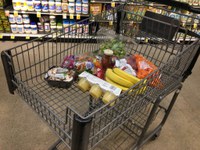Prairie Fare: Try These Questions About Storing Fruits and Vegetables
(Click an image below to view a high-resolution image that can be downloaded)
By Julie Garden-Robinson, Food and Nutrition Specialist
NDSU Extension
“This would be a good follow-up article,” my husband said with a grin.
I pondered his suggestion as I grabbed a grocery cart.
A while back, I wrote about a grocery shopping trip I took with our son. I was providing a “kitchen warming” gift for him after he moved into his own place. I stocked his cupboards, refrigerator and freezer with a variety of foods that he chose during our shopping trip.
I was amazed at the healthful choices he made. I should have had him be my guest writer that week, or perhaps our personal chef.
More than a year had passed. Was he still on the right track with eating?
“I mainly need fruits and vegetables,” our son noted as we entered the grocery store recently. My husband glanced in my direction with raised eyebrows. I nodded.
He placed peppers, tomatoes, carrots, raspberries, potatoes, grapes, bananas and mushrooms in the cart.
He had filled the cart with the amount of fruits and vegetables I might buy for a family of four to last for several days.
“Are you sure you are going to eat all the fresh fruits and vegetables before they spoil?” I asked.
“Yes, I’ll eat them, Mom,” he responded as he looked at some avocados. He thought they were a little pricy at this time of the year, so he didn’t add any to the cart.
I was fine with his choices. Fruits and vegetables typically are the food groups most lacking in the American diet. Only about one in 10 adults meets the daily 4 1/2-cup recommendation. All forms of fruits and vegetables, whether fresh, canned, frozen or dried, count toward the total.
Eating more fruits and vegetables can lower our risk for chronic disease, including cancer, diabetes and heart disease. They’re naturally low in calories and high in fiber.
Unfortunately, fruits and vegetables also are the foods most commonly wasted by Americans. Our son grew up in a family who tries to avoid wasting food. Throwing away food is like throwing money in the trash.
Try these questions about fresh fruit and vegetable storage:
- Why should you avoid storing fruits and vegetables, such as apples and broccoli, in the same refrigerator drawer?
- Where should you store fresh tomatoes?
- What’s the best way to clean fruits and vegetables?
- Should you rinse your weekly supply of fruits and vegetables before refrigerating? Why or why not?
- You check the strawberries you purchased a few days ago and notice they are moldy. Should you cut away the bad parts and use the rest?
- Why do “baby carrots” sometimes turn whitish?
- Let’s say you bought a lot of tomatoes, apples, carrots, peppers and other vegetables, and you have an unexpected trip that will take you out of state for many days. What should you do?
Here are the answers:
- Keep fruits such as apples, pears and plums away from vegetables such as lettuce, carrots and broccoli. Many fruits release ethylene gas naturally. In fruits, ethylene promotes ripening, but it can promote color changes or spoilage in ethylene-sensitive vegetables. However, if you use your fruits and vegetables quickly, you probably won’t have an issue with spoilage.
- Fresh tomatoes should be stored at room temperature to maintain their flavor and quality. However, cut tomatoes (and any other cut fruit or vegetable) should be covered and kept in the refrigerator for safety. Use within a few days.
- Use plenty of running water to clean vegetables and fruits. You should use a vegetable brush on fruits with “netted” skin, such as cantaloupe. Do not use soap.
- For best quality and longest storage life, rinse fruits and vegetables just prior to eating them.
- Throw away moldy strawberries.
- Baby carrots may “dry out” and become whitish. They are safe to eat. They will rehydrate in soups and stews. However, if baby carrots are slimy and soft, do not eat them.
- You could give your extra fruits and vegetables to a friend, or you could freeze, dry or can them. See https://www.ag.ndsu.edu/fieldtofork for information about storing and preserving various fruits and vegetables, and growing them, too.
Here’s a recipe and nutrition analysis courtesy of the U.S. Department of Health and Human Services. It features a variety of fresh vegetables and is ready in 30 minutes or less. Each serving has 2 cups of vegetables. I think my son had almost all the ingredients for this colorful, tasty recipe.
Chicken Ratatoullie
1 Tbsp. oil, such as olive, sunflower or canola
4 medium chicken breast halves, without skin, cut into 1-inch pieces
2 7-inch zucchini, unpeeled and thinly sliced
1 small eggplant, peeled and cut into 1-inch cubes
1 medium onion, thinly sliced
1 medium green pepper, cut into 1-inch pieces
1/2 pound fresh mushrooms, sliced
1 (16-ounce) can diced tomatoes
1 clove garlic, minced
1 1/2 tsp. dried basil, crushed
1 Tbsp. fresh parsley, minced
Black pepper
Heat oil in a large nonstick skillet. Add chicken and saute about three minutes. Add zucchini, eggplant, onion, green pepper and mushrooms. Cook for about 15 minutes. Add tomatoes, garlic, basil, parsley and pepper. Continue to cook for five minutes or until chicken is tender.
Makes four servings. Each serving has 270 calories, 7 grams (g) fat, 32 g protein, 21 g carbohydrate, 8 g fiber and 240 milligrams sodium.
(Julie Garden-Robinson, Ph.D., R.D., L.R.D., is a North Dakota State University Extension food and nutrition specialist and professor in the Department of Health, Nutrition and Exercise Sciences. Follow her on Twitter @jgardenrobinson)
NDSU Agriculture Communication - March 28, 2019
| Source: | Julie Garden-Robinson, 701-231-7187, julie.garden-robinson@ndsu.edu |
|---|---|
| Editor: | Ellen Crawford, 701-231-5391, ellen.crawford@ndsu.edu |



